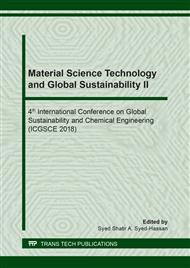[1]
E. Suali and R. Sarbatly, Conversion of microalgae to biofuel,, Renewable and Sustainable Energy Reviews, vol. 16, pp.4316-4342, (2012).
DOI: 10.1016/j.rser.2012.03.047
Google Scholar
[2]
L. Brennan and P. Owende, Biofuels from microalgae—a review of technologies for production, processing, and extractions of biofuels and co-products,, Renewable and sustainable energy reviews, vol. 14, pp.557-577, (2010).
DOI: 10.1016/j.rser.2009.10.009
Google Scholar
[3]
Y. Chisti, Biodiesel from microalgae,, Biotechnology advances, vol. 25, pp.294-306, (2007).
DOI: 10.1016/j.biotechadv.2007.02.001
Google Scholar
[4]
P. J. l. B. Williams and L. M. Laurens, Microalgae as biodiesel & biomass feedstocks: review & analysis of the biochemistry, energetics & economics,, Energy & Environmental Science, vol. 3, pp.554-590, (2010).
DOI: 10.1039/b924978h
Google Scholar
[5]
A. Converti, A. A. Casazza, E. Y. Ortiz, P. Perego, and M. Del Borghi, Effect of temperature and nitrogen concentration on the growth and lipid content of Nannochloropsis oculata and Chlorella vulgaris for biodiesel production,, Chemical Engineering and Processing: Process Intensification, vol. 48, pp.1146-1151, (2009).
DOI: 10.1016/j.cep.2009.03.006
Google Scholar
[6]
C. Yeesang and B. Cheirsilp, Effect of nitrogen, salt, and iron content in the growth medium and light intensity on lipid production by microalgae isolated from freshwater sources in Thailand,, Bioresource Technology, vol. 102, pp.3034-3040, (2011).
DOI: 10.1016/j.biortech.2010.10.013
Google Scholar
[7]
P. Singh, A. Guldhe, S. Kumari, I. Rawat, and F. Bux, Investigation of combined effect of nitrogen, phosphorus and iron on lipid productivity of microalgae Ankistrodesmus falcatus KJ671624 using response surface methodology,, Biochemical Engineering Journal, vol. 94, pp.22-29, (2015).
DOI: 10.1016/j.bej.2014.10.019
Google Scholar
[8]
D. J. Juntila, M. A. Bautista, and W. Monotilla, Biomass and lipid production of a local isolate Chlorella sorokiniana under mixotrophic growth conditions,, Bioresource Technology, vol. 191, pp.395-398, (2015).
DOI: 10.1016/j.biortech.2015.03.098
Google Scholar
[9]
Y. Shen, C. Chen, W. Chen, and X. Xu, Attached culture of Nannochloropsis oculata for lipid production,, Bioprocess Biosyst Eng, vol. 37, pp.1743-8, Sep (2014).
DOI: 10.1007/s00449-014-1147-z
Google Scholar
[10]
C. H. Hsieh and W. T. Wu, Cultivation of microalgae for oil production with a cultivation strategy of urea limitation,, Bioresour Technol, vol. 100, pp.3921-6, Sep (2009).
DOI: 10.1016/j.biortech.2009.03.019
Google Scholar
[11]
S. Ruangsomboon, Effect of light, nutrient, cultivation time and salinity on lipid production of newly isolated strain of the green microalga, Botryococcus braunii KMITL 2,, Bioresour Technol, vol. 109, pp.261-5, Apr (2012).
DOI: 10.1016/j.biortech.2011.07.025
Google Scholar
[12]
D. Morales-Sánchez, R. Tinoco-Valencia, M. A. Caro-Bermúdez, and A. Martinez, Culturing Neochloris oleoabundans microalga in a nitrogen-limited, heterotrophic fed-batch system to enhance lipid and carbohydrate accumulation,, Algal Research, vol. 5, pp.61-69, (2014).
DOI: 10.1016/j.algal.2014.05.006
Google Scholar
[13]
A. Fazeli Danesh, S. Ebrahimi, A. Salehi, and A. Parsa, Impact of nutrient starvation on intracellular biochemicals and calorific value of mixed microalgae,, Biochemical Engineering Journal, vol. 125, pp.56-64, (2017).
DOI: 10.1016/j.bej.2017.05.017
Google Scholar
[14]
T. Wang, X. Tian, T. Liu, Z. Wang, W. Guan, M. Guo, et al., A two-stage fed-batch heterotrophic culture of Chlorella protothecoides that combined nitrogen depletion with hyperosmotic stress strategy enhanced lipid yield and productivity,, Process Biochemistry, vol. 60, pp.74-83, (2017).
DOI: 10.1016/j.procbio.2017.05.027
Google Scholar
[15]
L. Ramanna, A. Guldhe, I. Rawat, and F. Bux, The optimization of biomass and lipid yields of Chlorella sorokiniana when using wastewater supplemented with different nitrogen sources,, Bioresource technology, vol. 168, pp.127-135, (2014).
DOI: 10.1016/j.biortech.2014.03.064
Google Scholar
[16]
S. Negi, A. N. Barry, N. Friedland, N. Sudasinghe, S. Subramanian, S. Pieris, et al., Impact of nitrogen limitation on biomass, photosynthesis, and lipid accumulation in Chlorella sorokiniana,, Journal of applied phycology, vol. 28, pp.803-812, (2016).
DOI: 10.1007/s10811-015-0652-z
Google Scholar
[17]
N. W. Rasdi and J. G. Qin, Effect of N:P ratio on growth and chemical composition of Nannochloropsis oculata and Tisochrysis lutea,, Journal of Applied Phycology, vol. 27, pp.2221-2230, (2014).
DOI: 10.1007/s10811-014-0495-z
Google Scholar
[18]
P. Selvakumar and K. Umadevi, Enhanced lipid and fatty acid content under photoheterotrophic condition in the mass cultures of Tetraselmis gracilis and Platymonas convolutae,, Algal Research, vol. 6, pp.180-185, (2014).
DOI: 10.1016/j.algal.2014.10.002
Google Scholar
[19]
M. J. Griffiths, R. P. van Hille, and S. T. Harrison, The effect of nitrogen limitation on lipid productivity and cell composition in Chlorella vulgaris,, Appl Microbiol Biotechnol, vol. 98, pp.2345-56, Mar (2014).
DOI: 10.1007/s00253-013-5442-4
Google Scholar
[20]
P. Singh, A. Guldhe, S. Kumari, I. Rawat, and F. Bux, Combined metals and EDTA control: An integrated and scalable lipid enhancement strategy to alleviate biomass constraints in microalgae under nitrogen limited conditions,, Energy Conversion and Management, vol. 114, pp.100-109, (2016).
DOI: 10.1016/j.enconman.2016.02.012
Google Scholar
[21]
G. Kim, J. Bae, and K. Lee, Nitrate repletion strategy for enhancing lipid production from marine microalga Tetraselmis sp,, Bioresour Technol, vol. 205, pp.274-9, Apr (2016).
DOI: 10.1016/j.biortech.2016.01.045
Google Scholar


